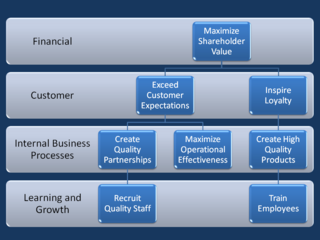
A business model describes how an organization creates, delivers, and captures value, in economic, social, cultural or other contexts. The process of business model construction and modification is also called business model innovation and forms a part of business strategy.
In the field of management, strategic management involves the formulation and implementation of the major goals and initiatives taken by an organization's managers on behalf of stakeholders, based on consideration of resources and an assessment of the internal and external environments in which the organization operates. Strategic management provides overall direction to an enterprise and involves specifying the organization's objectives, developing policies and plans to achieve those objectives, and then allocating resources to implement the plans. Academics and practicing managers have developed numerous models and frameworks to assist in strategic decision-making in the context of complex environments and competitive dynamics. Strategic management is not static in nature; the models can include a feedback loop to monitor execution and to inform the next round of planning.

Korean Confucianism is the form of Confucianism that emerged and developed in Korea. One of the most substantial influences in Korean intellectual history was the introduction of Confucian thought as part of the cultural influence from China.

In marketing, a coupon is a ticket or document that can be redeemed for a financial discount or rebate when purchasing a product.

John Thomas Dunlop was an American administrator, labor economist, and educator. Dunlop was the United States Secretary of Labor between 1975 and 1976 under President Gerald Ford. He was Director of the United States Cost of Living Council from 1973 to 1974, Chairman of the United States Commission on the Future of Worker-Management Relations from 1993 to 1995, which produced the Dunlop Report in 1994. He was also arbitrator and impartial chairman of various United States labor-management committees, and a member of numerous government boards on industrial relations disputes and economic stabilization.
Relationship marketing is a form of marketing developed from direct response marketing campaigns that emphasizes customer retention and satisfaction rather than sales transactions. It differentiates from other forms of marketing in that it recognises the long-term value of customer relationships and extends communication beyond intrusive advertising and sales promotional messages. With the growth of the Internet and mobile platforms, relationship marketing has continued to evolve as technology opens more collaborative and social communication channels such as tools for managing relationships with customers that go beyond demographics and customer service data collection. Relationship marketing extends to include inbound marketing, a combination of search optimization and strategic content, public relations, social media and application development.
The loyalty business model is a business model used in strategic management in which company resources are employed so as to increase the loyalty of customers and other stakeholders in the expectation that corporate objectives will be met or surpassed. A typical example of this type of model is: quality of product or service leads to customer satisfaction, which leads to customer loyalty, which leads to profitability.

In marketing, brand loyalty describes a consumer's positive feelings towards a brand, and their dedication to purchasing the brand's products and/or services repeatedly, regardless of deficiencies, a competitor's actions, or changes in the environment. It can also be demonstrated with other behaviors such as positive word-of-mouth advocacy. Corporate brand loyalty is where an individual buys products from the same manufacturer repeatedly and without wavering, rather than from other suppliers. Loyalty implies dedication and should not be confused with habit, its less-than-emotional engagement and commitment. Businesses whose financial and ethical values rest in large part on their brand loyalty are said to use the loyalty business model.

A strategy map is a diagram that documents the strategic goals being pursued by an organization or management team. It is an element of the documentation associated with the Balanced Scorecard, and in particular is characteristic of the second generation of Balanced Scorecard designs that first appeared during the mid-1990s. The first diagrams of this type appeared in the early 1990s, and the idea of using this type of diagram to help document Balanced Scorecard was discussed in a paper by Robert S. Kaplan and David P. Norton in 1996.
Customer satisfaction is a term frequently used in marketing. It is a measure of how products and services supplied by a company meet or surpass customer expectation. Customer satisfaction is defined as "the number of customers, or percentage of total customers, whose reported experience with a firm, its products, or its services (ratings) exceeds specified satisfaction goals." Customers play an important role and are essential in keeping a product or service relevant; it is, therefore, in the best interest of the business to ensure customer satisfaction and build customer loyalty.
Net promoter score (NPS) is a market research metric that is based on a single survey question asking respondents to rate the likelihood that they would recommend a company, product, or a service to a friend or colleague. The NPS is a proprietary instrument developed by Fred Reichheld, who owns the registered NPS trademark in conjunction with Bain & Company and Satmetrix. Its popularity and broad use have been attributed to its simplicity and transparent methodology.

Frederick F. Reichheld is an American New York Times best-selling author, speaker and business strategist. He is best known for his research and writing on the loyalty business model and loyalty marketing. He is the creator of the Net Promoter System of management (NPS).
Strategic planning software is a category of software that covers a wide range of strategic topics, methodologies, modeling and reporting.
Co-creation, in the context of a business, refers to a product or service design process in which input from consumers plays a central role from beginning to end. Less specifically, the term is also used for any way in which a business allows consumers to submit ideas, designs or content. This way, the firm will not run out of ideas regarding the design to be created and at the same time, it will further strengthen the business relationship between the firm and its customers. Another meaning is the creation of value by ordinary people, whether for a company or not.
Loyalty marketing is a marketing strategy in which a company focuses on growing and retaining existing customers through incentives. Branding, product marketing, and loyalty marketing all form part of the customer proposition – the subjective assessment by the customer of whether to purchase a brand or not based on the integrated combination of the value they receive from each of these marketing disciplines.
Customer retention refers to the ability of a company or product to retain its customers over some specified period. High customer retention means customers of the product or business tend to return to, continue to buy or in some other way not defect to another product or business, or to non-use entirely. Selling organizations generally attempt to reduce customer defections. Customer retention starts with the first contact an organization has with a customer and continues throughout the entire lifetime of a relationship and successful retention efforts take this entire lifecycle into account. A company's ability to attract and retain new customers is related not only to its product or services, but also to the way it services its existing customers, the value the customers actually perceive as a result of utilizing the solutions, and the reputation it creates within and across the marketplace.
The Advocacy Index is a customer survey technique developed by VIRTUATel Ltd that is conducted over the telephone. The technique measures customer loyalty using a 3-point scale and is based on the Net Promoter Score (NPS) methodology developed by Fred Reichheld.
In marketing, premiums are promotional items — toys, collectables, souvenirs and household products — that are linked to a product, and often require proofs of purchase such as box tops or tokens to acquire. The consumer generally has to pay at least the shipping and handling costs to receive the premium. Premiums are sometimes referred to as prizes, although historically the word "prize" has been used to denote an item that is packaged with the product and requires no additional payment over the cost of the product.
Customer delight means surprising a customer by exceeding their expectations and thus creating a positive emotional reaction. This emotional reaction leads to word of mouth. Customer delight directly affects the sales and profitability of a company, as it helps to distinguish the company and its products and services from the competition. In the past customer satisfaction has been seen as a key performance indicator. Customer satisfaction measures the extent to which the expectations of a customer are met. However, it has been discovered that mere customer satisfaction does not create brand loyalty nor does it encourage positive word of mouth.
Rob Markey is an American author, speaker, and business strategist. Often referred to as the Vince Lombardi of Customer Loyalty, he is perhaps best known for his research and writing on customer experience and loyalty marketing. Markey is also the co-creator of the Net Promoter System of management (NPS), along with fellow Bain & Company consultant Fred Reichheld.







